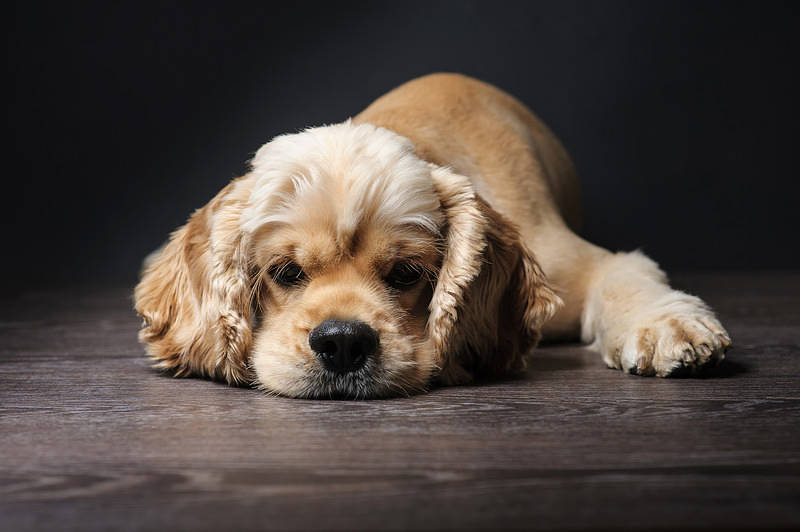What The Wizard of Oz was for the Cairn Terrier – an iconic and profile-boosting big-screen role, courtesy of the one and only “Toto” – so Lady & the Tramp was (in animated form) to the Cocker Spaniel, which spent on the order of a quarter-century as the most popular dog breed in the U.S. This sweet-natured, doe-eyed pooch hasn’t held that position for quite some time, but it certainly remains a widespread and familiar pet, cherished for its small size, luxuriant coat, and gentle, eager-to-please disposition.
Here we’ll be focusing on the American Cocker Spaniel; there’s also an English Cocker Spaniel of slightly different appearance, and while you’ll see both breeds on both sides of the pond the American or English Cocker is each more popular in its respective country of origin. (In the U.S., saying “Cocker Spaniel” without qualification usually indicates the American breed, and vice versa.)

The American Cocker Spaniel
Breed history
The American Cocker Spaniel derives from that venerable line of sporting dogs, the spaniels (or “spaynels”), that originated centuries ago in Spain as bird dogs. Though this category was once just broadly separated into “land spaniels” and “water spaniels,” by the 19th century a variety of specific breeds were being separated out and fine-tuned. These included the Cocker, bred in England as a gundog for sportsmen after that well-camouflaged upland gamebird the Woodcock (hence the breed name). This foundational Cocker Spaniel was a compact animal midway in size between the smaller English Toy (aka King Charles) Spaniel and the larger Springer Spaniel.
The Cocker had arrived on American shores by the late 1800s, and here breeders refined the spaniel into a smaller, lusher-coater version that ultimately became known as the American Cocker. The American Kennel Club (AKC) recognized this breed as separate from the taller, longer-headed English Cocker Spaniel in 1946.
Disney’s animated Lady & the Tramp – which featured an American Cocker Spaniel named “Lady,” a scruffy mongrel, and a now-classic spaghetti-eating sequence – came out in 1955, coinciding with the breed’s highest-profile decade yet. Richard Nixon’s Cocker Spaniel, Checkers, was by then a household name, thanks to the politician’s dog-referencing televised address in 1952 that became known as the “Checkers speech.”
Appearance
The American Cocker Spaniel stands between about 14 and 15.5 inches at the withers, and weighs from 24 to 30 pounds or so. The Cocker comports itself with a graceful, sloping profile, the topline easing down from the soft, round, floppy-eared head to the short hindquarters and the typically docked tail.
The American Cocker’s head has a domed top and a short, upturned muzzle with a deep stop in between. Another of the breed’s defining features is the plush feathering of the coat on the extravagant ears, the legs, and the belly.
American Cockers come in a range of colors, from black to roan to creamy; the officially recognized color categories are Black, Black With Tan Points, and Any Solid Color Other Than Black (ASCOB).
Personality and temperament
American Cocker Spaniels express a famously gentle and loving personality commonly and accurately described as “people-pleasing.” These are sensitive (though not wilting), affectionate, and even-tempered dogs that, when properly socialized, tend to do great around children and other pets. In short, they’re fabulous companions (if not watchdogs) for a wide range of owners and household settings.
Shedding & grooming
While they’re only moderate shedders, American Cocker Spaniels do require dedicated grooming, as one look at the silky, feathered coat should suggest. Give yours a thorough combing and brushing a few times a week, taking care when raking the thin, sensitive skin of the ears. Occasional professional grooming will keep the coat in good shape, as will periodic bathing (but, as the AKC notes, make sure to thoroughly rinse your spaniel to ward off the inflammation that can come from lingering soap residue).
Responsible grooming will help you head off at the pass the formation of mats within the Cocker’s coat, which can cause skin issues if left unaddressed.
Health and lifespan
Cocker Spaniels are generally long-lived purebreds, with a life expectancy of anywhere between 11 and 16 years. They’re also overall a pretty healthy breed. Some of the issues to watch out for include hip dysplasia, eye issues (such as glaucoma, cataracts, and progressive retinal atrophy), and ear ailments. The form of the Cocker’s drooping ears somewhat increases the likelihood of infections and inflammation.
Obesity can also be an issue with Cocker Spaniels, so closely regulate their food intake and make sure they’re getting regular exercise (see below).
Exercise needs
American Cocker Spaniels may be small and fancy-looking, but don’t forget these are bird dogs by heritage: They enjoy a good romp and need daily exercise to stay healthy (and keep a trim, muscular, gundog-worthy figure). Take them on a good walk or two a day, and give them attention, stimulus, and a workout with games of fetch and the like. If you’ve got a multi-dog household, your well-socialized Cocker will probably love getting some wiggles out in play with its four-legged roommates.
Training & intelligence
American Cocker Spaniels are smart and attentive learners; their attentive, approval-seeking nature means they’re usually quite easy to train. Reprimands needn’t be excessive: These are emotionally delicate dogs, and they’ll respond best to gentle corrections, praise, and edible rewards. The AKC notes that Cocker Spaniels are game for challenges, so pay attention to training activities that seem to especially engage and interest them and you’ll likely see the most satisfying results.
